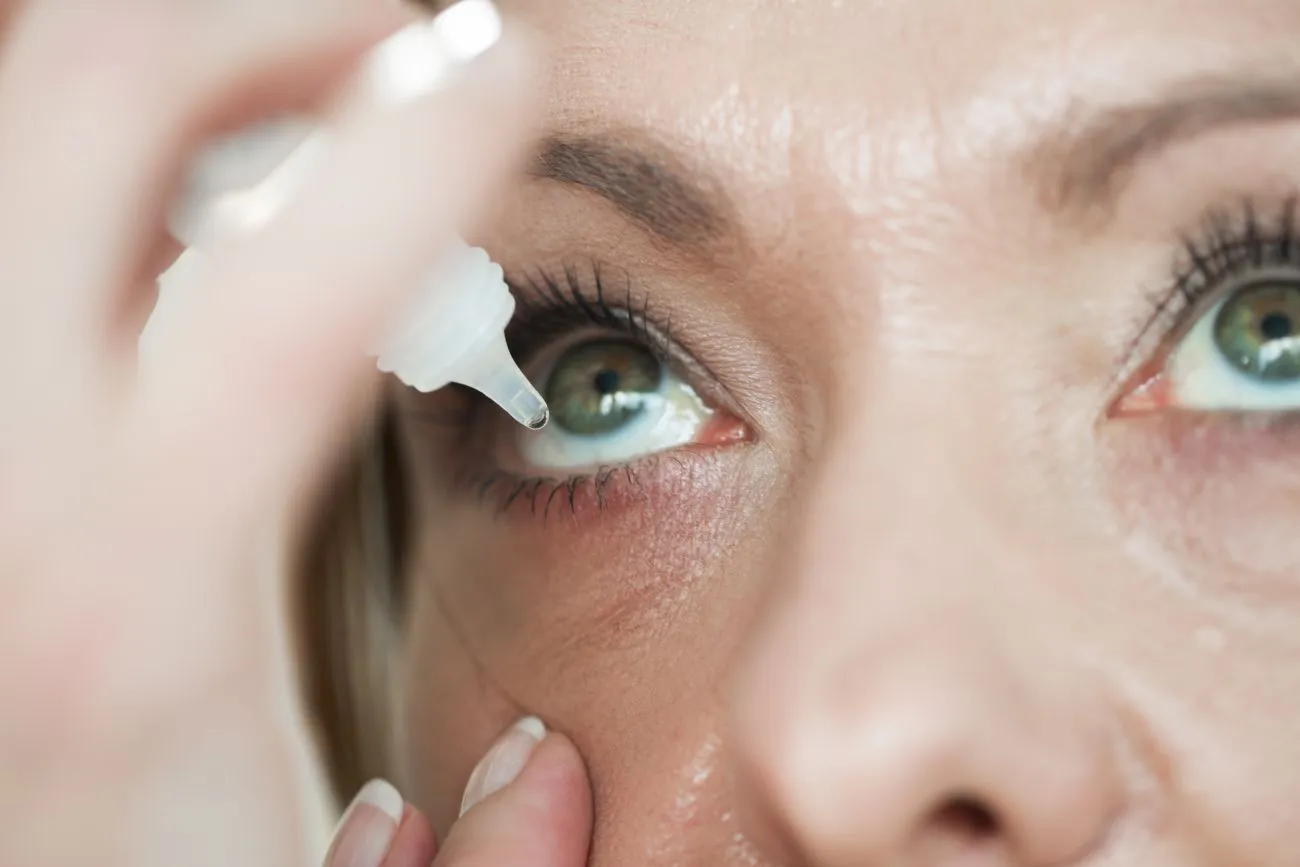Dry eye syndrome is an annoying condition in which your eyes feel itchy and irritated. The condition occurs when your tear ducts do not produce enough tears to provide moisture to your eyes. Dry eye is common in the U.S. and is most common in women and in older adults.
According to the American Academy of Ophthalmology, 3.2 million women and 1.68 million men over the age of 50 have dry eye. Pharmacy Times reports that 26 million Americans suffer from dry eye, and the number is expected to increase to 29 million by 2022.
Fortunately, dry eye is treatable, and there are several remedies from which you can select.
Eye Drops
There are both over-the-counter and prescription eye drops that are available to treat the symptoms of dry eye. If your dry eye symptoms are mild or occur infrequently, you can probably benefit by using over-the-counter artificial tears.
Over-The-Counter Eye Drops
The drops help by lubricating your eyes. Artificial tears may contain preservatives, or they might be preservative-free. The Mayo Clinic reports that people who use eye drops more than four times per day should choose preservative-free eye drops. Artificial tears that contain preservatives may irritate the eyes if they’re used more than four times per day. There are many brands of preservative-free artificial tears, including Systane Ultra, TheraTears, and Refresh Optive Advanced.
Pros of Over-the-Counter Eye Drops
- Inexpensive
- Widely available
- Provides relief for mild symptoms
Cons of Over-The-Counter Eye Drops:
- Drops with preservatives can irritate the eyes
- Not enough for moderate or severe dry eye symptoms
Prescription Eye Drops
Prescription eye drops are available for you if your symptoms occur more frequently or are more severe. The drops that you might be prescribed may depend on the underlying cause of your dry eyes. If your symptoms are caused by irritation to your corneas, you may be prescribed eye drops that contain corticosteroids or an immune-suppressing drug called cyclosporine.
If your dry eye symptoms are severe and other treatments haven’t worked, your doctor might prescribe autologous eye drops. These drops are made from your blood. Blood is drawn, and the plasma is separated out from the red blood cells. The plasma portion is then mixed with some salt to create the eye drops.
Pros of Prescription Eye Drops
- May help with more frequent or severe symptoms
- Can treat the underlying cause of dry eye symptoms
Cons of Prescription Eye Drops
- Only available by prescription
- Can be expensive
Prescription Medication
Your doctor might prescribe medications to help to alleviate your symptoms. Dry eye may be caused by inflammation along your eyelids. If you have inflammation along your eyelids, your doctor might prescribe oral antibiotics to treat the inflammation.
Doxycycline for Dry Eye
Medscape reports that your doctor might prescribe doxycycline one or two times per day to treat dry eye.
Pros of Doxycycline for Dry Eye
- Reduces eyelid inflammation
- Helps to treat gland issues
Cons of Doxycycline for Dry Eye
- May not be tolerated well by some patients
- Not usually recommended for younger people
Cholinergic Drugs for Dry Eye
If your tear ducts are producing an insufficient amount of tears, your doctor may prescribe cholinergic drugs to you. These drugs make you produce more tears and include cevimeline and pilocarpine or brands Evoxac and Isopto Carpine.
Pros of Cholinergic Drugs
- Help your tear ducts to produce more tears
- May help to restore the moisture balance in your eyes
Cons of Cholinergic Drugs
- May cause excessive sweating
- Only available by prescription
Medical Procedures
In addition to eye drops and prescription drugs, your doctor might recommend other medical procedures to help with dry eye symptoms.
Eye Inserts
Your doctor might recommend that you use eye inserts, which are tiny capsules that you insert between your eyelids and your eyes. They dissolve throughout the day to provide constant lubrication to your eyes. The brand name for these inserts is Lacrisert, and they contain hydroxypropyl cellulose.
Pros of Eye Inserts
- Can provide relief throughout the day
Cons of Eye Inserts
- Some people do not tolerate placing inserts in their eyes
Procedure to Close the Tear Ducts
In some people, dry eye results because the tears evaporate too quickly. To correct this problem, your doctor might recommend a procedure to close your tear ducts. Your doctor might use silicone plugs to plug your tear ducts, which can be removed. A permanent solution is called thermal cautery. This procedure uses heat to close the tear ducts.
Pros of Closing the Tear Ducts
- Can keep your tears on the surface of your eye for a longer period
Cons of Closing the Tear Ducts
- May aggravate symptoms if you have inflammation
- May cause a granuloma
LipiFlow Thermal Pulsation
If your dry eyes are caused by clogged oil glands, your doctor might recommend a procedure called LipiFlow thermal pulsation. This process involves using a cup-like instrument over the eye to give a warm massage to the eyelids. The procedure takes less than 15 minutes.
Pros of LipiFlow Thermal Pulsation
- May help to unclog oil glands
- Short, painless procedure
Cons of LipiFlow Thermal Pulsation
- Unclear whether it works any better than using warm compresses at home
Suffering from chronic dry eye can be uncomfortable. Fortunately, dry eye is treatable. If you have dry eye and over-the-counter eye drops are not working for you, you should talk to your doctor about other treatments that might be available.
